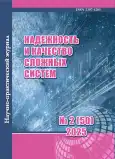DESIGN OF A SYSTEM FOR AUTOMATIC MONITORING OF MOBILE TERRITORIALLY SEPARATED OBJECTS
- Authors: Kubasov I.A.1, Lekar L.A.1
-
Affiliations:
- Academy of Management of the Ministry of Internal Affairs of the Russian Federation
- Issue: No 2 (2025)
- Pages: 5-14
- Section: FUNDAMENTALS OF RELIABILITY AND QUALITY ISSUES
- URL: https://journal-vniispk.ru/2307-4205/article/view/294411
- DOI: https://doi.org/10.21685/2307-4205-2025-2-1
- ID: 294411
Cite item
Full Text
Abstract
Background. Today, unmanned aerial vehicles (UAVs) are flying devices that can be controlled without human intervention, and are not just a fun toy. They are used to study the earth's surface, monitor forest fires and floods, and much more, and not only for peaceful purposes. At the same time, their capabilities are improving every day, and the scope of application is increasing at an incredible rate. Of particular relevance is the implementation of automatic monitoring of many different moving objects over a multi-kilometer territory to identify possible violations and ensure prompt suppression of these violations. The purpose of this work is to develop proposals for the design of a complex system and the creation of technology for the implementation of automatic monitoring of moving geographically dispersed objects. Materials and methods. The designed complex automatic monitoring system should consist of: a control point with a personal computer and Internet access; one or several UAV placement bases; UAVs with wireless Internet access; applications on smartphones/tablets of the employees of operational response groups to violations. The technology should be comprehensive (hybrid), allowing to obtain the required effect due to the use of UAVs, GLONASS positioning system, Internet of things, computer vision and communication system. Machine learning technologies are supposed to be used to solve the problems of object recognition. Results. Designing an automatic monitoring system for mobile geographically dispersed objects is a complex process that requires the involvement of specialists of various profiles: engineers, programmers, analysts and operators. A correctly designed and implemented system can significantly increase the effectiveness of control over the territory and ensure a timely response to any violations. Conclusions. The proposed system and hybrid technology for automatic monitoring of mobile geographically dispersed objects allow for a synergistic effect due to the integrated use of the GLONASS location system, UAVs, the Internet of Things, computer vision and communication systems.
About the authors
Igor A. Kubasov
Academy of Management of the Ministry of Internal Affairs of the Russian Federation
Author for correspondence.
Email: igorak@list.ru
Doctor of technical sciences, associate professor, professor of the sub-department of information technologies
(8 Zoi i Aleksandra Kosmodem'yanskikh street, Moscow, Russia)Lyudmila A. Lekar
Academy of Management of the Ministry of Internal Affairs of the Russian Federation
Email: antonna47@bk.ru
Candidate of technical sciences, associate professor of the sub-department of information technologies
(8 Zoi i Aleksandra Kosmodem'yanskikh street, Moscow, Russia)References
- Kaliev D.I., Shvets O.Ya. The system of forest fire exploration and monitoring on the base. Trudy universiteta = Proceedings of the University. 2023;(3):103–108. (In Russ.). doi: 10.52209/1609-1825_2023_3_103
- Kolesnikov V.M., Yakunin M.A. Prospects of using UAVs for environmental monitoring and safe operation of oil and gas pipelines. Chelovek. Obshchestvo. Inklyuziya (Prilozhenie) = Human. Society. Inclusion (Application). 2023;(S1-1):211–216. (In Russ.)
- Kubasov I.A., Sushkov V.I. Analysis of foreign innovative approaches to the use of unmanned aircraft in law enforcement. Vestnik Voronezhskogo instituta FSIN Rossii = Bulletin of the Voronezh Institute of the Federal Penitentiary Service of Russia. 2023;(1):64–71. (In Russ.)
- Kubasov I.A., Sushkov V.I. On a conceptual approach to the development and application of unmanned aircraft systems for special purposes. Vestnik Voronezhskogo instituta FSIN Rossii = Bulletin of the Voronezh Institute of the Federal Penitentiary Service of Russia. 2023;(4):86–95. (In Russ.)
- Martynov A.V., Kandyba V.E. Gradient descent method in machine learning. Shag v nauku = A step into science. 2022;(4):4–8. (In Russ.)
- Zaslavskiy M.M., Kryzhanovskiy K.E., Ivanov D.V. Development of an environmental monitoring system based on spatial marking and machine learning technologies. Izvestiya vysshikh uchebnykh zavedeniy Rossii. Radioelektronika = News of higher educational institutions of Russia. Radio electronics. 2023;26(4):56–69. (In Russ.). doi: 10.32603/1993-8985-2023-26-4-56-69
- Ivanov A.I., Kubasov I.A. Strong artificial intelligence: improving the quality of neural network solutions with the transition to processing large-volume input data. Nadezhnost’ i kachestvo slozhnykh system = Reliability and quality of complex systems. 2021;(1):9–16. (In Russ.). doi: 10.21685/2307-4205-2021-1-1
- Kubasov I.A., Sushkov V.I. On expanding the functionality of unmanned aircraft systems based on artificial intelligence. Bespilotnye vozdushnye suda v prakticheskoy deyatel'nosti pravookhranitel'nykh organov: sb. dokl. nauch.-prakt. spets. konf. v ramkakh Mezhdunar. voen.-tekhn. foruma (Kubinka, Moskovskaya obl., 16–18 avgusta 2022 g.) = Unmanned aircraft in the practical activities of law enforcement agencies : collection of scientific and practical reports. special conference within the framework of the International military-technical Forum (Kubinka, Moscow region, August 16-18, 2022). Moscow: NPO «Spetsial'naya tekhnika i svyaz'» MVD RF, 2022:30–32. (In Russ.)
- Kubasov I.A., Sushkov V.I. Application of artificial intelligence technologies in special-purpose robotic complexes in order to ensure law enforcement activities. Vestnik Voronezhskogo instituta FSIN Rossii = Bulletin of the Voronezh Institute of the Federal Penitentiary Service of Russia. 2022;(3):69–76. (In Russ.)
- Kubasov I.A. Industrial Internet of Things as a revolutionary development leap. Nadezhnost’ i kachestvo slozhnykh system = Reliability and quality of complex systems. 2023;(2):83–89. (In Russ.). doi: 10.21685/2307-4205-2023-2-9
Supplementary files





















